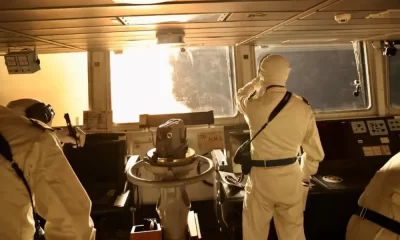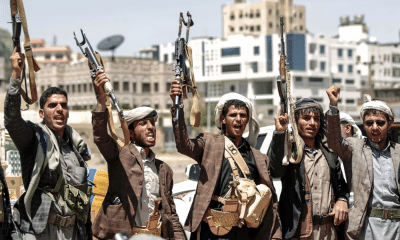World
US Navy Struggles to Combat Houthi Rebels in the Red Sea Corridor

The US Navy’s operation against the Houthi rebels, overshadowed by the Israel-Hamas conflict in the Gaza Strip, has become the Navy’s most intensive ongoing sea fight since World War II, according to Navy officers and experts.
The conflict confronts the Navy’s responsibility to keep international waterways open against a group whose old stockpile of assault rifles and pickup trucks has expanded into an almost limitless supply of drones, missiles, and other weaponry.
Since November, the Houthis have launched nearly daily strikes on more than 50 vessels, while shipping volume has plummeted in the critical Red Sea corridor that connects to the Suez Canal and the Mediterranean.
The Houthis claim the attacks are intended to end the fighting in Gaza and help the Palestinians, despite the fact that they are also attempting to bolster their position in Yemen. All indications are that the conflict will escalate, placing US sailors, friends, and commercial boats at risk.
The U.S. Navy prepared for decades to potentially fight the Soviet Union, then later Russia and China, on the world’s waterways. But instead of a global power, the Navy finds itself locked in combat with a shadowy, Iran-backed rebel group based in Yemen.
The U.S.-led campaign against the Houthi rebels, overshadowed by the Israel-Hamas war in the Gaza Strip, has turned into the most intense running sea battle the Navy has faced since World War II, its leaders and experts told The Associated Press.
US Navy fighting Missiles and Drones
The combat pits the US Navy’s mission to keep international waterways open against a group whose former arsenal of assault rifles and pickup trucks has grown into a seemingly inexhaustible supply of drones, missiles and other weaponry.
Near-daily attacks by the Houthis since November have seen more than 50 vessels clearly targeted, while shipping volume has dropped in the vital Red Sea corridor that leads to the Suez Canal and into the Mediterranean.
The Houthis say the attacks are aimed at stopping the war in Gaza and supporting the Palestinians, though it comes as they try to strengthen their position in Yemen. All signs suggest the warfare will intensify — putting U.S. sailors, their allies and commercial vessels at more risk.
“I don’t think people really understand just kind of how deadly serious it is what we’re doing and how under threat the ships continue to be,” Cmdr. Eric Blomberg with the USS Laboon told the AP on a visit to his warship on the Red Sea.
“We only have to get it wrong once,” he said. “The Houthis just have to get one through.”
The pace of the fire can be seen on the Arleigh Burke-class destroyer, where the paint around the hatches of its missile pods has been burned away from repeated launches. Its sailors sometimes have seconds to confirm a launch by the Houthis, confer with other ships and open fire on an incoming missile barrage that can move near or beyond the speed of sound.
“It is every single day, every single watch, and some of our ships have been out here for seven-plus months doing that,” said Capt. David Wroe, the commodore overseeing the guided missile destroyers.
One round of fire on Jan. 9 saw the Laboon, other vessels and F/A-18s from the aircraft carrier USS Dwight D. Eisenhower shoot down 18 drones, two anti-ship cruise missiles and a ballistic missile launched by the Houthis.
Nearly every day — aside from a slowdown during the holy Muslim fasting month of Ramadan — the Houthis launch missiles, drones or some other type of attack in the Red Sea, the Gulf of Aden and the narrow Bab el-Mandeb Strait that connects the waterways and separates Africa from the Arabian Peninsula.
The Navy saw periods of combat during the “Tanker Wars” of the 1980s in the Persian Gulf, but that largely involved ships hitting mines. The Houthi assaults involve direct attacks on commercial vessels and warships.
“This is the most sustained combat that the U.S. Navy has seen since World War II — easily, no question,” said Bryan Clark, a former Navy submariner and a senior fellow at the Hudson Institute. “We’re sort of on the verge of the Houthis being able to mount the kinds of attacks that the U.S. can’t stop every time, and then we will start to see substantial damage. … If you let it fester, the Houthis are going to get to be a much more capable, competent, experienced force.”

Destroyer USS Laboon: AP Image
Dangers at sea and in the air
While the Eisenhower appears to largely stay at a distance, destroyers like the Laboon spend six out of seven days near or off Yemen — the “weapons engagement zone,” in Navy speak.
Sea combat in the Mideast remains risky, something the Navy knows well. In 1987, an Iraqi fighter jet fired missiles that struck the USS Stark, a frigate on patrol in the Persian Gulf during the Iran-Iraq war, killing 37 sailors and nearly sinking the vessel.
There’s also the USS Cole, targeted in 2000 by boat-borne al-Qaida suicide bombers during a refueling stop in Yemen’s port city of Aden, which killed 17 on board. AP journalists saw the Cole patrolling the Red Sea with the Laboon on Wednesday, the same day the Houthis launched a drone-boat attack against a commercial ship there that disabled the vessel.
That commercial ship was abandoned on Friday and left adrift and unlit in the Red Sea, the British military’s United Kingdom Maritime Trade Operations center said.
Rear Adm. Marc Miguez, the Navy’s commander for its Carrier Strike Group Two, which includes the Eisenhower and supporting ships, said the Navy had taken out one underwater bomb-carrying drone launched by the Houthis as well during the campaign.
“We currently have pretty high confidence that not only is Iran providing financial support, but they’re providing intelligence support,” Miguez said. “We know for a fact the Houthis have also gotten training to target maritime shipping and target U.S. warships.”
Asked if the Navy believed Iran picks targets for the Houthis, Miguez would only say there was “collaboration” between Tehran and the rebels. He also noted Iran continues to arm the Houthis, despite U.N. sanctions blocking weapons transfers to them.
Iran’s mission to the United Nations told the AP that Tehran “is adept at thwarting the U.S. strategy in a way that not only strengthens (the Houthis) but also ensures compliance with the pertinent resolutions.”
The risk isn’t just on the water. The U.S.-led campaign has carried out numerous airstrikes targeting Houthi positions inside Yemen, including what the U.S. military describes as radar stations, launch sites, arsenals and other locations. One round of U.S. and British strikes on May 30 killed at least 16 people, the deadliest attack acknowledged by the rebels.
The Eisenhower’s air crews have dropped over 350 bombs and fired 50 missiles at targets in the campaign, said Capt. Marvin Scott, who oversees all the air group’s aircraft. Meanwhile, the Houthis apparently have shot down multiple MQ-9 Reaper drones with surface-to-air missile systems.
“The Houthis also have surface-to-air capabilities that we have significantly degraded, but they are still present and still there,” Scott said. “We’re always prepared to be shot at by the Houthis.”
A stalemated war
Officers acknowledge some grumbling among their crew, wondering why the Navy doesn’t strike harder against the Houthis. The White House hasn’t discussed the Houthi campaign at the same level as negotiations over the Israel-Hamas war.
There are several likely reasons. The U.S. has been indirectly trying to lower tensions with Iran, particularly after Tehran launched a massive drone-and-missile attack on Israel and now enriches uranium closer than ever to weapons-grade levels.
Meanwhile, there’s the Houthis themselves. The rebel group has battled a Saudi-led coalition into a stalemate in a wider war that’s killed more than 150,000 people, including civilians, and created one of the world’s worst humanitarian disasters.
The U.S. directly fighting the Houthis is something the leaders of the Zaydi Shiite group likely want. Their motto long has been “God is the greatest; death to America; death to Israel; curse the Jews; victory to Islam.” Combating the U.S. and siding publicly with the Palestinians has some in the Mideast praising the rebels.
While the United States and its European allies police the waterways, Saudi Arabia has mainly been silent, seeking a peace settlement with the Houthis. According to reports, certain Middle Eastern countries have begged the United States not to initiate attacks on the Houthis from their territory, making Eisenhower’s presence even more crucial.
The carrier’s deployment has been extended, and its crew has only made one port stop since its deployment a week after the October 7 Hamas attack on Israel.
Obama and Yemen
In 2015, US President Barack Obama began assisting a Saudi-led coalition against Houthi rebels in Yemen. The goal was to restore Yemen’s government, which the Houthis had deposed.
Obama approved logistical support, intelligence sharing, and weaponry sales to the coalition. Critics believe that this assistance exacerbated a humanitarian disaster, killing thousands of civilians and pushing millions to the edge of hunger.
Proponents argue that it was important to oppose Iranian influence in the region, given Tehran’s support for the Houthis. Despite objectives, the war has lingered on, causing enormous misery among Yemen’s people.

































